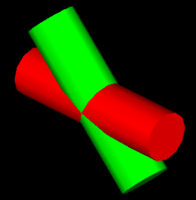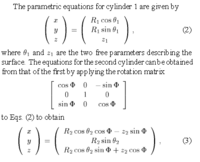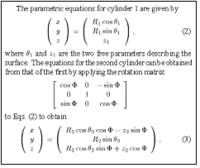markraz
Full Member
- Joined
- Feb 19, 2014
- Messages
- 338
Hi am trying to understand the intersection of two cylinders that are not perpendicular. Either cylinder could be at any rotation in space.

So would I need 3 unique vectors for U V W for each cylinder? total of 6 vectors?
would I set the equations up like this? where
v = is for vector
i, j, k are vector components for each vector
6 vectors = 1, 2, 3, 4, 5, 6
t, s, tt, ss = time
r1, r2 = radius
cylinder 1 vectors
u = v1
v = v2
w = v3
r1 cos(t) (v1i ,v1j , v1k) + r sin (t) (v2i ,v2j , v2k) + s (v3i, v3j, v3k)
cylinder 2 vectors
u = v4
v = v5
w = v6
r2 cos(tt) (v4i ,v4j , v4ak) + r sin (tt) (v5i ,v5j , v5k) + ss (v6i, v6j, v6k)
Is this how to set it up?
if so. once I setup these equations what do I do now to find the intersection? do I somehow solve for t and s?
thanks in advance

So would I need 3 unique vectors for U V W for each cylinder? total of 6 vectors?
would I set the equations up like this? where
v = is for vector
i, j, k are vector components for each vector
6 vectors = 1, 2, 3, 4, 5, 6
t, s, tt, ss = time
r1, r2 = radius
cylinder 1 vectors
u = v1
v = v2
w = v3
r1 cos(t) (v1i ,v1j , v1k) + r sin (t) (v2i ,v2j , v2k) + s (v3i, v3j, v3k)
cylinder 2 vectors
u = v4
v = v5
w = v6
r2 cos(tt) (v4i ,v4j , v4ak) + r sin (tt) (v5i ,v5j , v5k) + ss (v6i, v6j, v6k)
Is this how to set it up?
if so. once I setup these equations what do I do now to find the intersection? do I somehow solve for t and s?
thanks in advance



